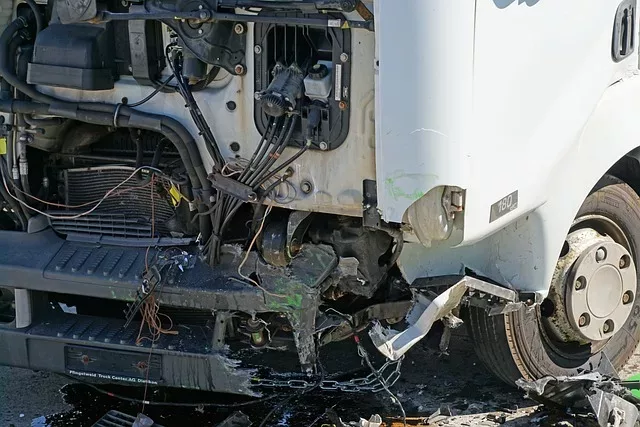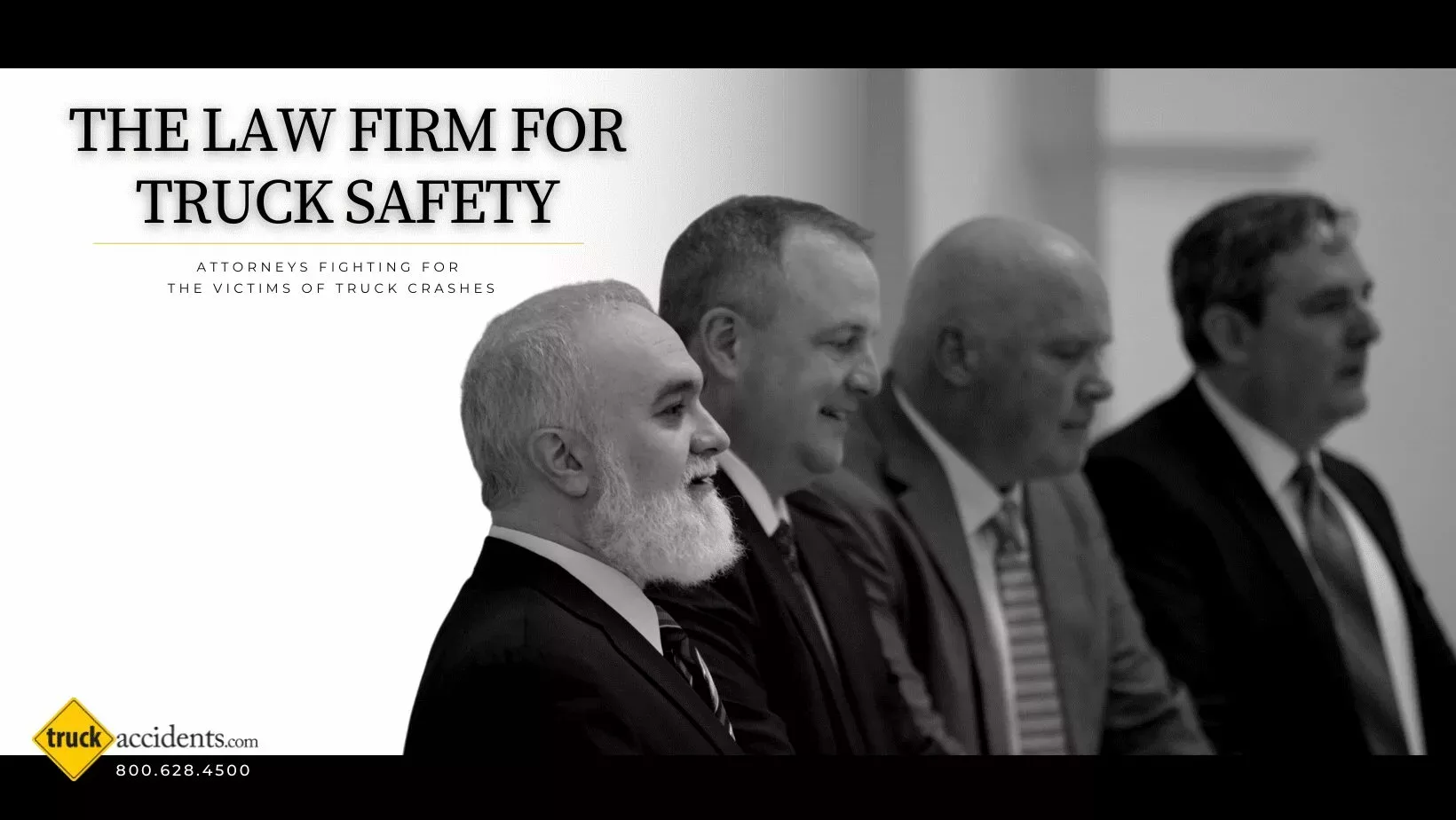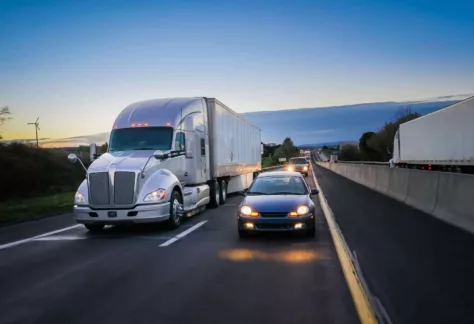The American Association for Justice Trucking Litigation Group includes approximately 400 lawyers who litigate collisions involving commercial motor vehicles. Our members see the devastation that occurs in many truck crashes. The current minimum insurance limits are inadequate in thousands of cases each year. Between 70%-100% of fatal and catastrophic liabilityLegal responsibility for one's acts or omissions. In negligence cases, liability includes proving negligence (see definition or hyperlink), proving causation (see definition), and resulting damages (see definition or hyperlink). truck crash cases exceed the current minimum insurance limits.
The current minimum insurance requirement of $750,000 for most tractor trailers and large trucks on the road has not been adjusted for inflation since it was proposed nearly 35 years ago. The time is now to adjust the limits, taking into account inflation, to help insure that truck companies—and not already overtaxed programs like Medicare, Medicaid and Tricare—are held accountable to pay for future medical care, lost salary and other losses experienced by victims of truck collisions. These victims include car drivers, bus riders, pedestrians and often other truck drivers.
One of the original purposes of federally-mandated insurance minimums was increased safety entry standards for motor carriers who wish to transport people and goods. This continues to be a goal of insurance. The motor carrier or driver who can’t afford insurance also can’t afford routine maintenance of brakes, tires and other equipment. Such drivers can best serve the public safely by either raising capital to afford insurance and other expenses necessary for safety, or to seek employment with a motor carrier with the financial capital to operate safely. With the reported driver shortage, there are motor carriers with trucks sitting idle who are looking for safe drivers with starting salaries of $60,000 and more.
Driving a tractor trailer or other commercial motor vehicle (CMV)A motor vehicle or combination used for transport of goods or passengers for hire. is a privilege; not a right. Up until deregulation in the 1980s, it was illegal to drive a CMV unless a motor carrier had legal rights to a particular route. Even then, the carrier could only drive authorized routes. Deregulation opened the field so that nearly any driver could become a motor carrier by meeting minimal filing, regulatory and insurance requirements. To allay concerns about putting potentially unsafe drivers behind the wheel of a CMV, increased insurance limits were proposed so that insurance companies would have an incentive to offer safety training programs and not insure carriers that posed an unacceptable risk.
Motor Carrier Enforcement agents do the best they can with available resources. Less than 2% of carriers receive safety audits because there simply aren’t enough government resources. That was part of the goal of deregulation: insurance companies would actively participate in a safety role so that free market forces would encourage safety training for drivers and carriers and would increase premiums or refuse to insure carriers when they represented an unacceptable risk.
The trucking industry was deregulated at a time when $750,000 was considered a lot of money. Now, $750,000 or $1 million (which is most common) is just not that much money when compared to the cost of medical care for the catastrophically injured and average lifetime salaries of victims killed in large truck crashes. With less relative risk now than existed in 1980, insurance companies do not have the same financial incentive to screen and train.
The legislative history of creating minimum insurance levels in 1980 included the recognition that minimum levels were set to “assure the public safety is not jeopardized”. Another part of that history was setting insurance minimums to achieve a level “sufficient to require on site inspection by the insurance company with minimums to be updated regularly.” (H.R. Rep. No. 96-1069 at 43, emphasis added.)
It is basic economics that all prices must eventually be adjusted for inflation. The time has passed to adjust the minimum insurance limits.
We believe that most drivers and carriers want to do the right thing and be able to compensate for any catastrophic loss they cause. While all carriers wish to be profitable, it is only a small minority that will act unsafely to save a buck, including skimping on safety, insurance and maintenance. Once passed, small and large carriers will comply with any new regulation and purchase insurance more appropriate for 2015 than 1980.
Questions 1-4 Premium Rates
When insurance companies write larger policies, they help ensure safety by reviewing driver history, CSA and other safety scores, drug and alcohol compliance and other safety measurements. The insurance company has a financial interest in keeping people safe; the motor carrier has a financial interest in safety compliance to help prevent premium increases.
John Burtch, President of Dawson Transportation Services, a transportation insurance provider, estimates the following costs for purchasing insurance in excess of the $1 million for which most carriers are currently insured:
Fleet size Price per power unit
(Additional Limit purchased or required)
1-10
$1,000,000 $ 800
$2,000,000 $1,200
$3,000,000 $1,500
$4,000,000 $1,750
11-50
$1,000,000 $ 650
$2,000,000 $ 950
$3,000,000 $1,200
$4,000,000 $1,500
51-250
$1,000,000 $ 550
$2,000,000 $ 850
$3,000,000 $1,050
$4,000,000 $1,250
(Comments given at the May 19, 2014 Motor Carrier Safety Advisory Committee and provided by Dawson Transportation Services.) These estimates are for non-hazardous material carriers. Dawson Transportation Services writes a majority of insurance contracts in the Midwest, so regional factors could result in slightly different premiums. The estimates above have a margin of error of ± 10% for 90% of the motor carriers. Of course, depending on safety record and other market forces, the increase could be less or more, especially for the top 10% of carriers with the worst safety histories.
Referrals & Co-Counsel
Involved in a Crash?
No other law firm knows trucks quite like us. Our trucking law expertise and trial experience allow us to win multi-million-dollar results year after year.
Our team of truck accident attorneys works tirelessly to help your family find justice in the wake of a catastrophic truck crash.
Referrals & Co-Counsel
No other law firm knows trucks quite like us. Our trucking law expertise and trial experience allow us to win multi-million-dollar results year after year.
Involved in a Crash?
Our team of truck accident attorneys works tirelessly to help your family find justice in the wake of a catastrophic truck crash.
Current Minimum Levels of Financial Responsibility
Question 5. How often is the minimum level of financial responsibility insufficient to meet the actual costs associated with a crash, specifically for lifelong medical support?
Current minimums are insufficient to meet actual costs associated with a crash in 70-100% of fatal and catastrophic liability collisions.


Adjusted for Medical Consumer Price Index (United States Bureau of Labor Statistics, 1980-2014 Medical CPI, www.BLS.gov), $750,000 as originally proposed in 1980 is equivalent to $4,838,206 in 2015 dollars.
In 1980, when a person was killed in a large truck crash, $750,000 of insurance coverage would pay for 60 years of salary, using the national average wage index of an average salary of $12,513. Today, the same minimum limits will only pay for 16 years of salary to the family of the deceased.

Reviewing large truck crash fatalities by age, it is clear that the current minimum insurance limits are not sufficient to replace lost income to the household to compensate the family of the person killed. According the chart above, more than 70% of people killed in truck crashes are between the ages of 18-55. Assuming an average salary of $44,888, the current minimum limits are insufficient to replace the lost income experienced by people in this age range. This does not include last medical expenses before death or other compensable losses.
Confidentiality is why some people can make wildly low estimates of the number of annual claims that exceed $750,000. Insurance companies routinely insist on confidentiality of dollar amount in exchange for settling cases. We estimate 7,500 to 10,000 people per year are killed or catastrophically injured in truck crashes where the value of the loss—including salary replacement for the family and future medical care—exceeds the current $750,000 minimum insurance levels. Adjusted for liability, assuming a conservative estimate that only 25% of truck crashes are the fault of the truck driver, this still leaves at least 1,875-2,500 victims undercompensated annually.
These numbers or higher are supported by the first data known to be publically disclosed by the trucking industry. Motor carriers who belong to The Trucking Alliance tracked 8,692 commercial motor vehicle settlements between 2005 and 2011 and found the 42% of monetary exposure represented in these settlements exceeded the current minimum insurance levels of $750,000. (Trucking Alliance Study)
Based on an average nursing home cost of $77,000 annually for a semi-private room in a nursing home and $42,000 annually for an assisted care facility (Source: Genworth 2014 Cost of Care Survey of 10,000 assisted living facilities and nursing homes), a catastrophically injured 20 year old requires $4,400,000 for semi-private nursing home care or $2,400,000 for an assisted living facility, assuming she will live to a life expectancy age of 77. This does not include the cost of any doctor’s care, hospital visits, surgeries or durable medical equipment. It has also not been increased for future health care cost inflation. Many life care plans for a person catastrophically injured in a commercial motor vehicle collision are $2 million to $5 million or higher.
Here are some examples of what is involved in a life care plan and how it affects just a few real people whose lives—and the lives of their family members—have changed due to a collision with a large truck. Their life care plans include expenses for medication, skilled care, therapy services, surgeries, home modifications, household replacement services and medical equipment and supplies. Due to the graphic nature of the injuries in these crashes, the following photos only show victims before the crash.

Photo by Andrea Piacquadio via Pexels
The life care plan above is from a 2010 Wisconsin collision. A truck lost control on I-94 coming to rest blocking all lanes of traffic. The injured person is a 28 year old female working as an account manager for a large lender. She suffered severe brain trauma resulting in a coma. She still remains in a semi-vegetative state. Past medical bills are $1,046,790.07. Her future medical costs range from $5,508,492.00 for institutional care to $13,537,200 for home care.
In 2012, Tony was hit by a tractor-trailer that crossed the median and hit him head on in the opposite lane and continued into the woods. The truck driver claimed he was reaching for an apple. Tony suffered severe orthopedic injuries and mild traumatic brain damage. The life care plan estimates that continued care would range between $3.1 million to $4.7 million.


In Pennsylvania in 2009, a family minivan carrying 10 year-old Davanna was stopped at a red light. The truck driver had never driven a tractor trailer in snow before. The truck skidded through the red light and slammed into the minivan, striking it, and catapulting it almost 50 feet.
Davanna was airlifted to Children’s Hospital in Pittsburgh as a level one trauma patient. Her body temperature had to be lowered in an attempt to preserve her brain tissue. A hole was drilled into her skull reduce pressure on her brain. She was sedated, paralyzed, and needed mechanical ventilation to live.
Her slow process to recovery included regular and intense physical rehabilitation therapy every day. Davanna now attends a school for children with special needs.
The accident altered Davanna’s and her family’s lives drastically. Investigations after the crash revealed that this truck needed more than five different kinds of brake safety improvements – putting it in direct violation of federal laws.
The motor carrier only had a $1 million insurance policy. Her life care plan is over $9 million. Since her father was in the Army, Tricare has paid some of her bills, but not all.
Impacts of Increasing the Minimum Level of Financial Responsibility
Question 7. Would an increase in financial responsibility requirements affect small and large motor carriers differently? If so, how?
Some small and many larger carriers already have $5 million or more coverage. Some carriers have $100 million or more. For carriers choosing limits in excess of the current minimum, there would likely be no change or a small decrease in premiums since they would no longer have to absorb the cost of excess claims when smaller carriers are involved in fatal and catastrophic collisions.
Question 8. How would increasing the minimum financial responsibility requirements affect the ability of a carrier to obtain insurance?
Increasing the minimum should have no effect on a carrier’s ability to obtain insurance. A motor carrier that is financially unable to afford a $1250-$1750 increase in insurance premiums is running on such a tight budget that it is also the carrier likely unable to afford safety-critical preventative maintenance.
An increase will make it more difficult for “chameleon” carriers with unsafe histories to obtain insurance. The FMCSA has established higher vetting standards in recent years for new entrants. An increased insurance minimum will complement the agency’s efforts to keep unsafe operators off the roads. According to the Government Accountability Office (GAO), 18% percent of chameleon carriers are involved in severe crashes, triple the rate for non-chameleon carriers. In 2010, the GAO estimates that the FMCSA was only able to check 2% of new carriers to identify if they were chameleon carriers. With significantly higher limits comes higher risk for insurance companies. Accordingly, they will be incentivized to screen new insurance applicants that have repeatedly refused to give drug tests, ignored hours of service regulations and violated other safety rules that puts them at an unfair competitive advantage compared to carriers who follow the rules.
Question 9. How would increasing minimum levels of financial responsibility affect safety , e.g., would carriers put off “optional costs” such as safety programs, preventive maintenance and investments in new technology, to cover the high cost of premiums?
Increasing the minimums will make the roads safer.
Small carriers will not choose to pay increased insurance premiums instead of safely maintaining their trucks. A carrier either has a safety culture or it does not. When faced with pocketing an extra $1250-$1750 or reinvesting it in capital, safety programs or insurance premiums, a company that cares about safety will make sure it is doing what it reasonably can to run safely. Carriers that are operating on a profit of less than $1750 and have to choose between new brakes or insurance premiums, are carriers that are not adequately capitalized to operate safely in the first place.
Question 10. What are the current State insurance requirements and how do they vary from the Federal requirements?
State limits are much different from federal requirements because they do not affect interstate commercial vehicles up to 80,000 pound vehicles.
Question 12. What percentage of insurance-related cases settles before trial at the current minimum levels of financial responsibility? If the minimum levels are increased, would the same percentage of cases settle before trial?
This information is kept strictly confidential by insurance companies. Motor carriers who belong to The Trucking Alliance tracked 8,692 commercial motor vehicle settlements between 2005 and 2011 and found the 42% of monetary exposure represented in these settlements exceeded the current minimum insurance levels of $750,000. (Trucking Alliance Study)
Settlements occur when the two sides agree on a settlement value. There will not likely be a difference in the percentage of cases settled before trial with increased minimum insurance limits. There will be a dramatic decrease in litigation against trucking brokers and shippers when the motor carrier’s liability limits are increased.
Compensation
Question 13. What minimum levels of financial responsibility are needed to adequately protect against uncompensated losses associated with crashes?
$4.8 million would account for inflation as adjusted by the Medical Consumer Price Index, calculating from 1980 to the beginning of 2015. Given the time inherent in agency rulemaking, we recommend a minimum limit of $5 million.
Question 14. What other mechanisms, besides increased minimum levels of financial responsibility, are available to more fully compensate persons who suffer catastrophic loss?
Insurance is how Americans protects against risk. Increased insurance limits in the 1980s were an important safety mechanism and integral part of deregulation. Compensation funds and other experiments are not sustainable and will not work. Insurance is designed to spread risk based on safety. It is an important part of our free market system.
Question 15. How would increasing the minimum financial responsibility requirements affect out-of-court crash damage settlement agreements?
Increasing minimums should not affect settlements at all. Those who are at fault will still be at fault. Insurance companies are experts at evaluating claims; the value of each truck accident claims will not change based on the amount of available insurance. Insurance companies will not pay a single dollar more than it values a claim given its risk. That is, if an insurance company values a claim at $2 million, it is not going to pay more if there is $3 million insurance versus $5 million.
With an increased minimum limit, motor carriers that currently carry minimum insurance will have decreased risk and exposure of their assets. Insurance companies will be able to make settlement decisions based more on value of loss than concerns about excess exposure of the motor carrier.
Increasing the insurance minimum levels will cause a dramatic decrease in the increasing litigation against brokers and shippers.
On behalf of the thousands of victims who are undercompensated or have become increasing financial burdens on Medicaid, Medicare, Tricare and state workers compensation programs, we urge the FMCSA to adjust the minimum insurance limits to 2015 dollars as originally promised and anticipated.
Respectfully submitted,
American Association for Justice, Trucking Litigation Group
Michael Jay Leizerman, Public Affairs Chair
(800) 628-4500
AAJ Trucking Litigation Group
Submitted by: Michael Jay Leizerman, Public Affairs Chair
Docket FMCSA-2014-0211


